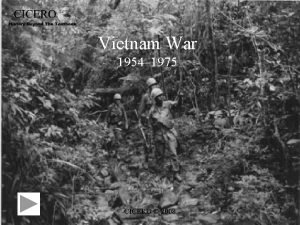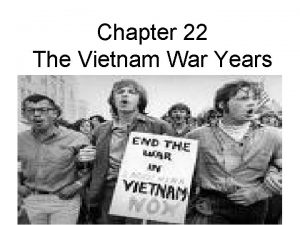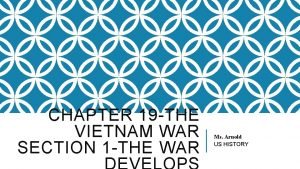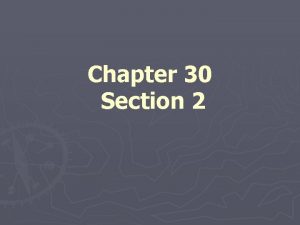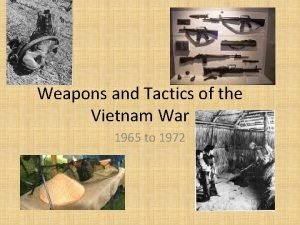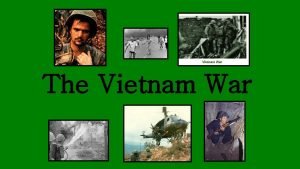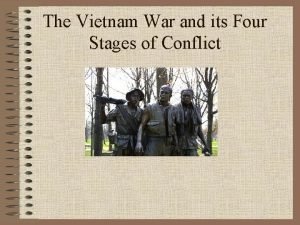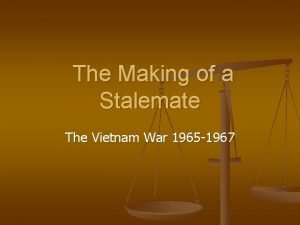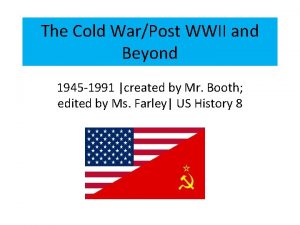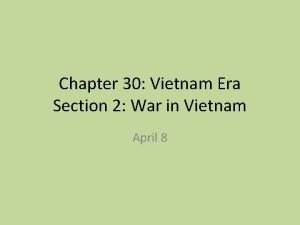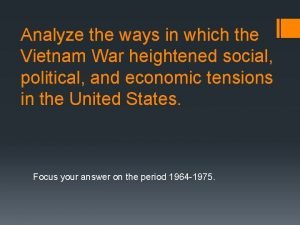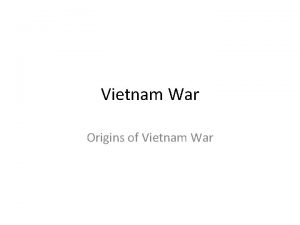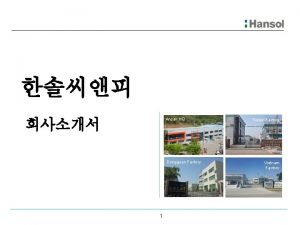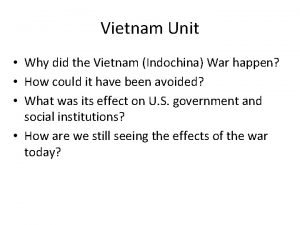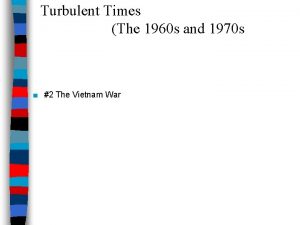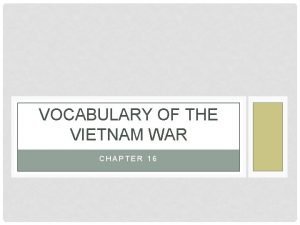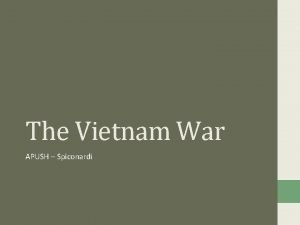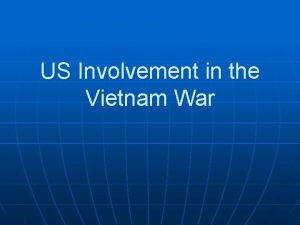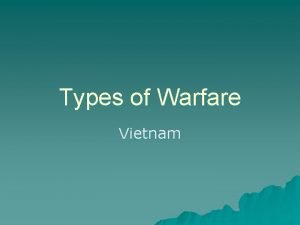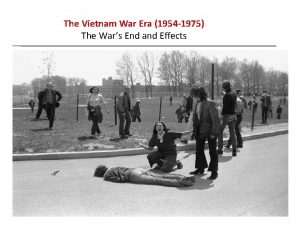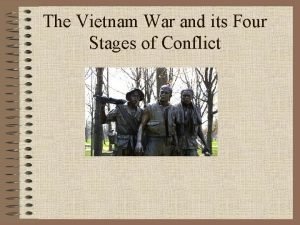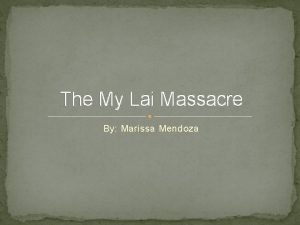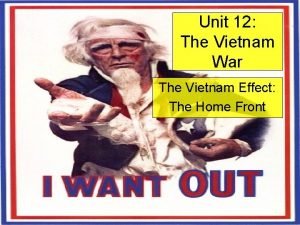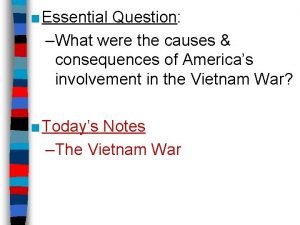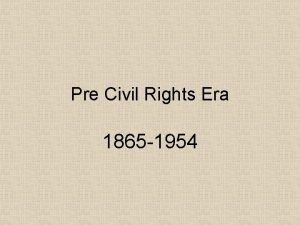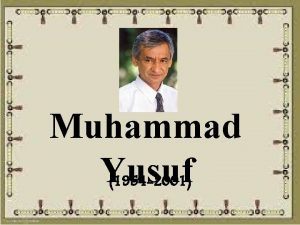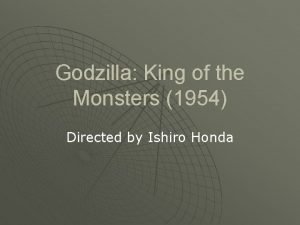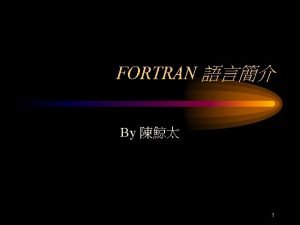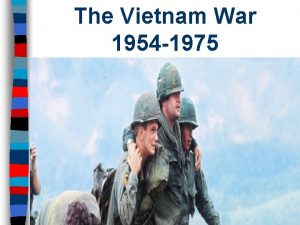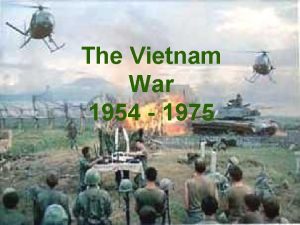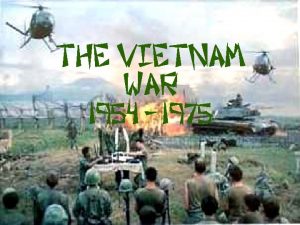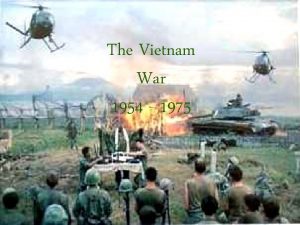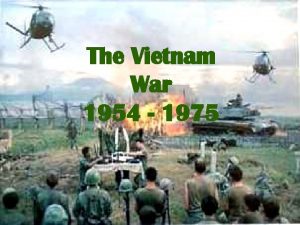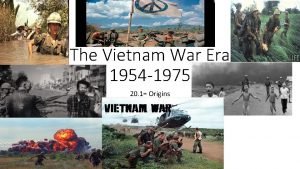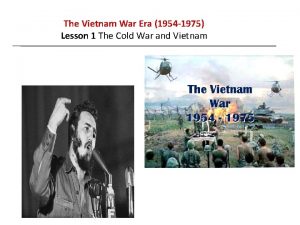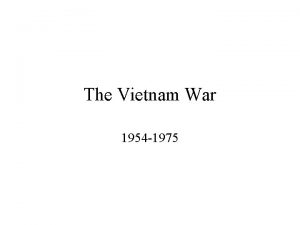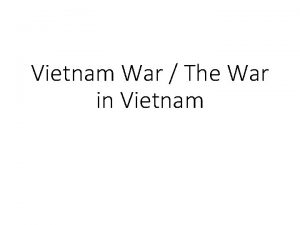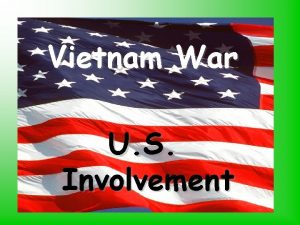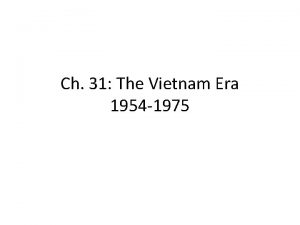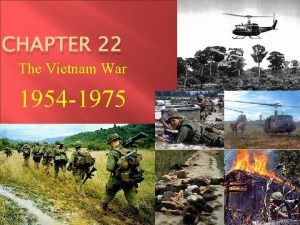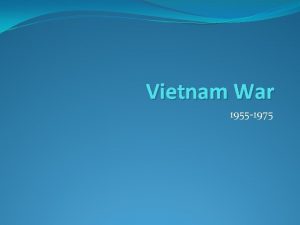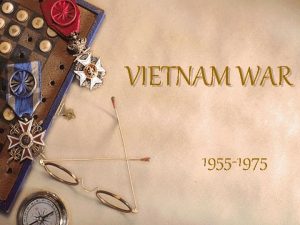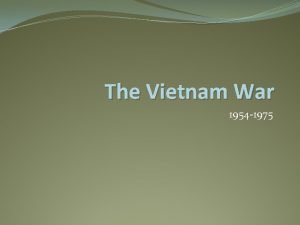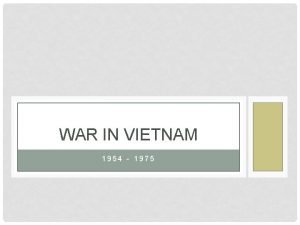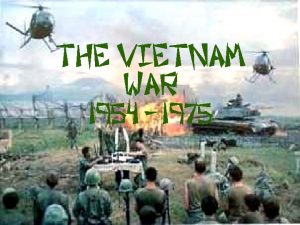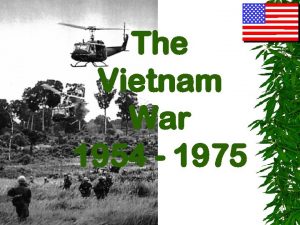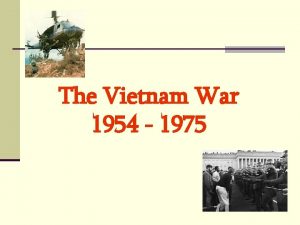Chapter 25 The Vietnam War Era 1954 1975































- Slides: 31

Chapter 25 The Vietnam War Era 1954 -1975

The Beginnings • US involvement in Vietnam started in 1954 when we were supporting the French who were trying to gain back control and we wanted to stop the spread of communism

THE RISE OF HO CHI MINH • France had controlled Vietnam, Laos and Cambodia for rice and rubber profit and started taking away freedoms when these nations started protesting • B/c of this, many people fled to China • 1924 they started to organize under Ho Chi Minh and he created the Indochinese Communist Party • Japan took over Vietnam during WWII and when they left, Minh declared, under his new party – The Vietminh – they would make Vietnam independent (communist)

Asian Containment • France said no independence and put troops back there in 1945 regaining control of the south • US had supported Minh during WWII but now we sent $2. 6 bil. over the next 4 years to help the French (from 19501954) • All to stop the spread of Communism

US IN INVOLVEMENT GROWS INDO-CHINA • Domino theory – in 1954, Eisenhower told the country that the Communist countries were like this and if one went, they all would…right around Korea stalemate • Dien Bien Phu – France surrendered here in May 1954 in Northwestern Vietnam – 15, 000 casualties • Geneva Accords – May to July 1954, France, UK, USSR, US, China, Laos, Cambodia, Vietminh met here and divided Vietnam in two along the 17 th parallel – North = Communist, South = Nationalists – Free elections scheduled for 1956 to unify the country again

VIETCONG: THE “VC”. . . BAD GUYS IN THE SOUTH • The leader of the South, Ngo Dinh Diem, saw that Minh had a lot of support and cancelled the elections in 1956 • He was a Catholic and started restricting the practice of Buddhist and his gov’t was corrupt • Vietcong sprung up as a Communist group against Diem and Minh supported the group supplying weapons to them along the Ho Chi Minh trail • We continued to support Diem (non-communist) and JFK sent more money and military advisers (16, 000 Special Forces) to help

Turmoil and Protests against Diem in the South • Diem was persecuting more and more. . . Buddhists were protesting by burning themselves (immolation) • US urged him to stop but finally backed a coup on 11/1/63. . he was then assassinated • The South went into turmoil and the Vietcong got stronger

A DECLARATION OF ESCALATION • 8/2/64 N. Vietnam fired on USS Maddox patrolling Gulf of Tonkin and 2 days later, N. Vietnam supposedly fired again at them • Gulf of Tonkin Resolution Aug 7, 1964 - gave Johnson the authority to assist any SE Asian country whose gov’t was fighting Communism…allowed the president to use any force w/o declaring war • Operation Rolling Thunder Feb 1965 – 1 st sustained bombing of NV that Johnson authorized after the Vietcong killed US troops at Pleiku w/ the hope that intensive bombing would stop N. Vietnam from aiding the Vietcong. • By June 1965, 50 K US troops were fighting the Vietcong. . . by 1968, 500, 000 troops

. . . and the troops keep going to Asia • • • Robert Mc. Namara – Johnson’s Secretary of Defense who helped him decide to send more troops to Vietnam in March of 1965 William Westmoreland – the commander in S. Vietnam…he kept asking for more troops b/c he said the Army of the Republic of Vietnam wasn’t good…by 1968 – 500 k us troops were there Between 1965 -1973, they dropped 6 million tons of bombs (3 x’s WWII)

The Horrors of War • US wanted to win over locals so the Vietcong wouldn’t be able to hide w/them • US used Napalm – which set fire to the jungle and people, and Agent Orange – leaf killing toxic chemical, to root out tunnels and hideouts but this often hurt locals. . . caused cancer • Search and destroy missions


Fighting Tactics of the “Enemy” • • • The Vietcong used a tunnel system and would attack in the cities and jungles. The Vietcong would travel light, attack at night w/ ambushes and set booby traps. They wanted to wear the US down so we would leave Westmoreland wanted to beat them by a war of attrition – wearing them down by continuous harassment…he also introduced the “body county” By the end of 1968, we had 500 k troops there and 30 k had died

Two Camps of Thought • • As the war waged on w/no clear victor, some troops weren’t as keen about protecting S. Vietnam when some of the citizens didn’t seem like they wanted help. Back home, Congress divided into Hawks – people who supported Johnson (conservatives) and Doves – People who were against Johnson’s war policy (liberals, students, pacifists, civil rights leaders). . . Senator J. William Fulbright’s public hearings

MEDIA VS. GOVERNMENT • Inflation was up from 2% to 5. 5% by 1969 and in 1967, Johnson asked for a tax hike but had to cut funding for “The Great Society” • Westmoreland Mc. Namara said there was a light but the Media portrayed a diffferent picture as this was US’s 1 st “living room war” and thus emerged a “credibility gap” between what the gov’t and the media was telling the public • Senator Fulbright had the Fulbright hearings (‘ 66) in which he charged that Johnson wasn’t portraying the war the way it was

Home Front • • • The draft/selective service system was around from the Selective Service Act of 1948 but since many didn’t agree w/the war, people tried to get out of it by medical or college. Since upper class whites were predominately the ones in college, it became a working class/minority war At the start AA suffered 20% of combat deaths and only made up 12% of US pop. . . instituted random drawings for draft

STUDENTS AND THE WAR • New Left – growing youth movement of the 60’s…demanded sweeping changes in US…old left was from 30’s and they wanted to move US toward socialism • Students for a Democratic Society (SDS) – Founded in 1960 @ Univ of MI – corp. and gov’t have taken over US and they wanted a restoration of participatory democracy and greater individual freedom and end of war. . . ”tune in and drop out” • Free speech movement – started at UC Berkley. . . had to have “their speech and ideas”

Protest movement: College kids Who Didn’t Want to Fight For Freedom/Get Drafted Like Other Poor Kids • • 1)war was a civil war 2)S. Vietnam is no better then the communists 3) we shouldn’t be policing the world SDS called for people to flee to Canada b/c Johnson said you had to be in good academic standing to get a deferment. 200 k men were accused of draft offenses, 4 k imprisoned, 10 k fled to Canada 10/1967 75 k went to DC to protest

1968: Tet and the Loss of Moral • • 1/30/68 was the new year known as Tet and there was supposed to be a week long truce. The Vietcong launched the Tet Offensive which is they attacked 100 towns, cities and 12 US air bases and US embassy…this went on for a month before US and S. Vietnam could regain control…Vietcong lost 32 k vs US and S. Vietnam 3 k during the battle…this showed the enemy was not giving up

LBJ CALLS IT QUITS IN 1968 • After Tet, public opinion dropped and in late Feb 1968, 60% disapproved of LBJ’s handling of the war • Before Tet, the (D) party had said they were going to get a anti-war candidate for the election…Eugene Mc. Carthy stepped up. • In 3/68 he only lost to LBJ by a little bit and b/c of that, RFK (Robert Kennedy) decided to run. • 3/31/68 LBJ announced a pull out of troops and then stated he wasn’t going to run again…the Great Society was in decline

The Democratic Convention of 1968 Erupts into Violence • • April – MLK is assassinated by James Earl Ray June – RFK is assassinated by Sirhan College campuses continued to erupt in protest Violence erupted in Chicago at the 1968 (D) national convention as 10 k protesters came there to get the (D) to adopt an anti-war platform…Hubert Humphrey had already been chosen as the nominee…LBJ’s VP

ELECTION OF 1968 • Nixon won the election that year on a platform that he would restore law and order and to end the war. • Before he had lost to JFK in 1960, lost for Governor of CA but he started working for a law firm in NY and in 1966 helped (R) win some seats in Congress • Nixon immediately announced a troop withdrawal • By Aug 1969 25 k had returned home and over the next 3 yrs it dropped from 500 k to 250 k • This gradual reduction was known as Vietnamization – so the S. Vietnamese could take a more active role in their gov’t…Henry Kissinger, the National Security Advisor helped devise the plan


SECRET BOMBINGS OF THE IMPERIAL PRESIDENCY • As part of the Vietnamization, Nixon wanted to have “Peace w/ Honor” – have dignity while pulling out of Vietnam • He also wanted to make sure the US had a say as to the outcome of the war – i. e. S. Vietnam gov’t remain free • He also had bombs dropped on Cambodia and Laos. . . where Ho Chi Minh Trail and Vietcong hideouts were

My Lai Incident • • In 11/69 NY Times reported that on 3/16/68 a platoon lead by William Calley, were searching for Vietcong They found them in My Lai, Military Intelligence said to shoot and kill the village residents (about 200) Calley was the only soldier sentenced to prison Happened during Tet Offensive and was stopped by a US chopper pilot (Hugh Thompson)

Cambodia and Laos • • On 4/30/70 Nixon told the US that US troops had invaded Cambodia to clear out N. Vietnamese and Vietcong supply centers however he didn’t tell Congress until after…in response, Congress repealed Gulf of Tonkin Resolution In response, 1. 5 million students went on strike closing down 1, 200 campuses in protest

KENT STATE AND JACKSON STATE INCIDENTS • Student protest led to burning of ROTC building • National guard was called in • 5/4/70, guard fires into crowd of protesters that were throwing rocks at them and kills 4 and wounds 9 • 5/14/70 same thing happened in Jackson State, MS, 12 wounded, 2 killed

Pentagon Papers • • 6/71, former DOD worker Daniel Ellsberg told everyone about these 7 k pg document told that LBJ had drawn up plans for the war as he was promising the nation he wouldn’t send troops…it also showed there was no plan to end the war as long as N. Vietnam was fighting Documents showed gov’t hadn’t been honest Nixon tried to block publication of the papers but SC ruled in favor of NY times in NY Times v United States

WAR’S END • 1/27/73 Paris Peace Accords – Between the US, N. Vietnam, S. Vietnam and Vietcong - to end war – N. Vietnam troops would remain in S. Vietnam but Nixon said US would retaliate if truce was broken • POW’s would be returned, Non-communist gov’t would remain in power in S. Vietnam • 3/29/73 Last of US troops leave • Fall of Saigon – 2 yrs later, N. Vietnam attacked Saigon and captured the city…S. Vietnam surrendered and Vietnam was Communist

Aftermath • 58 k US troops died and 303 k were injured • 2 mil S. Vietnam and N. Vietnam troops died • 3. 3 mil suffered from post traumatic stress • Vietnam memorial was created in 1982 to pay tribute

War Powers Act • President must inform Congress w/in 48 hrs of sending troops into a hostile area and can only keep them there for 90 days • Also, the draft was abolished, people were now sketchy of what the gov’t told them

Detente and Kissinger • Devised by Nixon and Kissinger, it was a policy to ease cold war tension…based off of “Real Politik” which was looking at a country’s power rather than philosophy • SALT I Treaty – After Nixon visited USSR and China. said it set # of ballistic missiles and sub missiles to ‘ 72 levels • This was one of Nixon’s biggest achievements along with establishing relations with China
 1975-1954
1975-1954 Description
Description Presidential and congressional reconstruction venn diagram
Presidential and congressional reconstruction venn diagram The domino theory vietnam war
The domino theory vietnam war Chapter 19 the vietnam war
Chapter 19 the vietnam war Chapter 30
Chapter 30 Us weapons vietnam war
Us weapons vietnam war Results of vietnam war
Results of vietnam war Stages of the vietnam war
Stages of the vietnam war Did the vietnam war end in a stalemate
Did the vietnam war end in a stalemate Civil war digging deeper webquest answers
Civil war digging deeper webquest answers Causes of the vietnam war
Causes of the vietnam war Analyze the ways in which the vietnam war heightened social
Analyze the ways in which the vietnam war heightened social Ngo dinh diem pronunciation
Ngo dinh diem pronunciation Vietnam war
Vietnam war Napalm vietnam war
Napalm vietnam war Vietnam war 1960
Vietnam war 1960 Vietnam war vocabulary
Vietnam war vocabulary Vietnam war apush
Vietnam war apush Vietnam
Vietnam Punji trap victim
Punji trap victim Reason for vietnam war
Reason for vietnam war Effects of the vietnam war
Effects of the vietnam war Stages of the vietnam war
Stages of the vietnam war Marissa lai
Marissa lai Vietnam
Vietnam What were the causes and effects of the vietnam war
What were the causes and effects of the vietnam war 15 th ammendment
15 th ammendment Magnétoscope 1954
Magnétoscope 1954 Muhammad yusuf qayerda tug'ilgan
Muhammad yusuf qayerda tug'ilgan Godzilla king of the monsters 1954
Godzilla king of the monsters 1954 Fortran 1954
Fortran 1954
